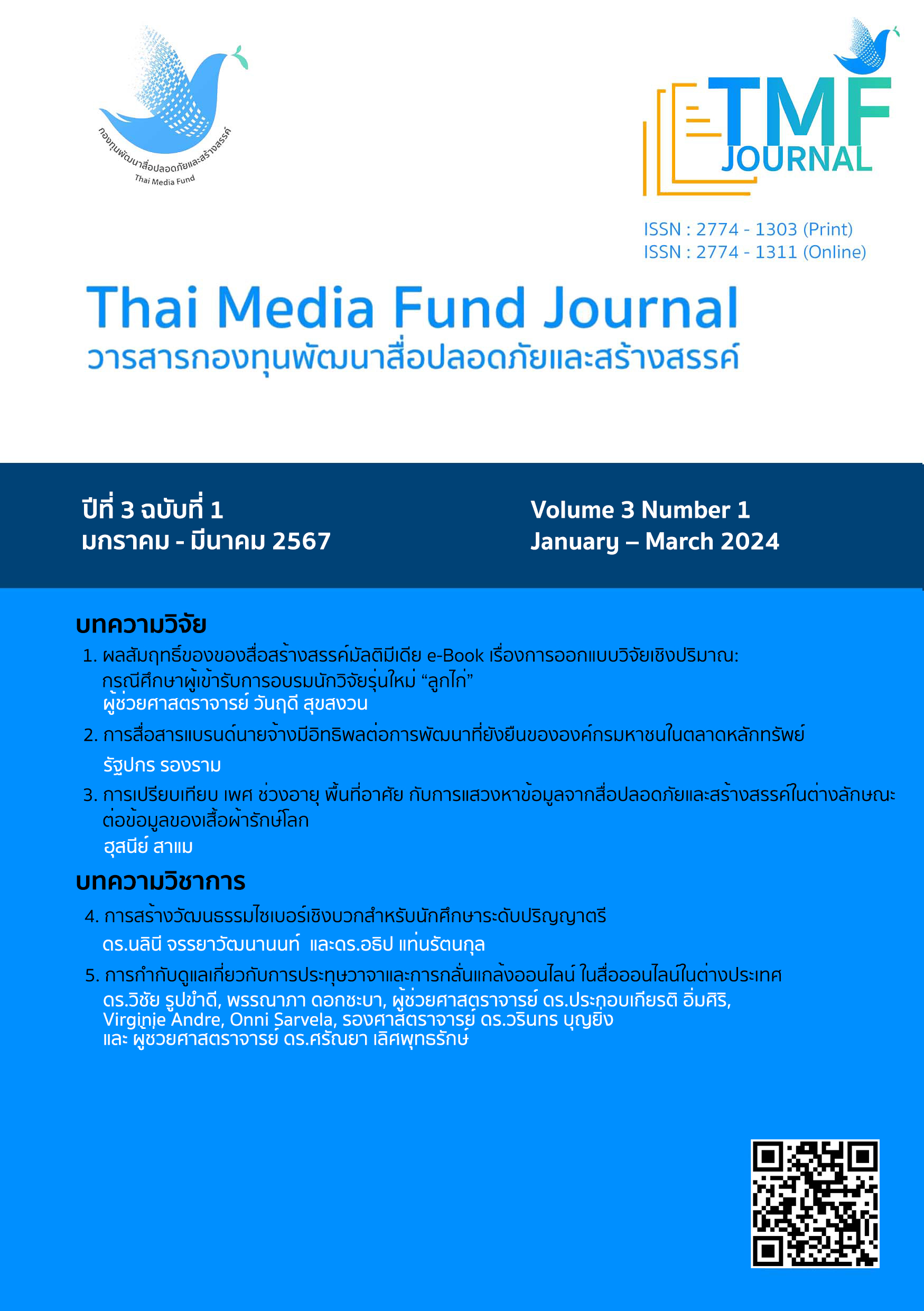Comparing gender, age groups, living areas, seeking information from secure and creative media outlets in various forms, regarding sustainable fashion data
Main Article Content
Abstract
This research is quantitative research. The purpose of this study was to investigate the additional value of rags as well as the decision-making process for purchasing upcycling products. The researcher collected data by conducting the filling out quantitative research questionnaires. The study included 52 consumers of fabric scrap products. The research sampling was non-specific sampling methods. Data were analyzed using statistics: mean score, percentage, frequency, standard deviation T-test and Anova
The results of this study showed that gender differences in the decision-making process for buying second-hand fabric that creating value-added are difference at statistically significant at 0.05, but with different ages and domicile, the decision-making process for buying second-hand fabric that creating value-added is not different. The study could serve as a guideline for policy recommendations from the Environment Agency or other related organizations to promote SME products made from fabric scraps, or the information could be used for marketing to create a purchasing decision process that effectively reaches consumer groups.
Keywords: Fabric Scraps, Added Value, Purchasing Decision Process
Article Details

This work is licensed under a Creative Commons Attribution-NonCommercial-NoDerivatives 4.0 International License.
References
Amnueysit, P. (2017). Circular economy: Transforming resource crisis through a new economic system. Retrieved from https:// www.scbeic.com/th/detail/product/3831 Marketeer Editor.
Bartlett, A. A. (1998). Reflections on sustainability, population growth, and the environment. Retrieved from https://www.albartlett.org/articles/art_reflections_part_1.html
Bonini, S., and Swartz, S. (2014). Profits with purpose: How organizing for sustainability can benefit the bottom line. McKinsey on Sustainability & Resource Productivity, 2(1), 1-15.
Borker, D. R. (2014). Social media marketing in emerging economies: A mongolian case study. International Journal of Marketing Studies, 6(2), 31-45.
Brismar, A. (2017). Circular fashion: Green strategy. Retrieved from https://circularfashion.com/circular-fashion-defnition
Chaiyachan, S. (2000). Marketing management. Bangkok: Odian Store.
Chuaychunoo, P. (2016). Factors affecting consumer buying decisions about goods on social media. Independent Research, Master of Business Administration.Thammasat University.
Data Reportal. (2022). Didital2022: Thailand. Retrieved from https://datareportal.com/reports/digital-2022-thailand
de Chematony, L., Riley, F. D., & Harris, F. (1998). Criteria to assess brand success. Journal of Marketing Management, 14(7), 765-781.
Environment and Pollution Control Office 13 (Chonburi). (2018). Environmental pollution issues along with good prevention and solution guidelines. Retrieved from https://www.mnre.go.th/ reo13/th/news/detail/9373
Environmental Journal. (2022). Smoke from Biomass Burning May Pose Greater Risks Than Anticipated. Retrieved from https://ej.eric.chula.ac.th/article/view/336
Gomenthai, J. (2019). Circular fashion. Retrieved from https://www.thaitextile.org/th/insign/detail.1122.1.0.html
Kidd, C. V. (1992). The evolution of sustainability. National Emergency Training Center.
Law, M., & Mark, Ng. (2016). Age and gender differences: Understanding mature online users with the online purchase intention model. Journal of Global Scholars of Marketing Science, 26(3), 248-269.
Longtunman. (2020). Fast fashion: When clothing harms the world, creating waste and pollution. Retrieved from https://www.longtunman.com
Marketting Oops. (2018). Revealing intriguing statistics of Facebook Live on Its 2nd Anniversary. Retrieved from https://www.marketingoops.com/media-ads/social-media/facebook-live-2-years/
Moneyandbanking. (2023). Textile recycling. Retrieved from https://moneyandbanking.co.th/2023/20829/.
Panomyong, A. (2016). The emerging global trend: E-commerce business. Retrieved from https://www.unile.com
Phromsiri, P. (2004). Marketing strategies for the age of change. Nation Business.
Pollution Issues and Effective Prevention and Remediation Approaches. Retrieved from https://www.mnre.go.th/reo13/th/news/detail/9373
Popraithong, W. (2013). Factors affecting the decision making on purchasing cloths from the online stores. An Independent Study for the master’s degree Thammasat University. Bangkok.
Pongwitthayanukul, P. (2017). 8 techniques for integrating social media into traditional marketing. Article from Bangkok University.
PPTV Online. (2021). Fast fashion when clothing harms the world: Generating waste and pollution. Retrieved from https://www.pptvhd36/news/forgien/160568 vernetwork.com/th/business-editoria/social-lcommerce
Samerjai, C. 2005. The small business management. Bangkok: SE-Education.
Schiffman, L. G., & Kanuk, L. L. (1991). Consumer behavior (4th ed.). New Jersey: Englewood Cliffs.
Srisa-ard, B. (1992). Preliminary research (3rd ed)., Bangkok: Suwiriyasarn.
Subsrisunjai, W. (2017). Fashion design identity by using the brand archetype concept. Journal of Culture and Arts Institute, Srinakharinwirot University, 18(2), 118-126.
Wongrujirawanich, S. (2011). Sustainable design. Bangkok: Bangkok Business.
Textile Industry Development Institute. (2011). Thai textile statistics 2010/2011. Textile Industry Development Institute.
Thai Media Fund. (2018). Annual report of the security and creative media development fund. Bangkok: Thai Media Fund.
ThaiPublica. (2018). Upcycling the Ocean fashion sustainability circular economy. Retrieved from https://thaipublica.org/2018/08/upcycling-the-ocean-fashion-sustainability-circular-economy.
Thai Media Fund Journal. (2021). Definition of innovation for safe and creative media development. Retrieved from https://shorturl.asia/P47bS
Tipphachartyothin, P. (2014). Quality control: The importance of consistency. Journal of Productivity world, 19(110), 91-96.
Wiphawin, N. (2003). New product development skills. Bangkok: SE-Educations
Wongboonngam, A. (2018). Media exposure and knowledge seeking of mass communication students in Bangkok. Bangkok: Rajamangala University of Technology Phra Nakhon.
Yamlao, P. (2018). Circular economy chapter 22: Examples of businesses and industries driving change. Retrieved from http://www.allaroundplastics.com/article/sustainability/2069


